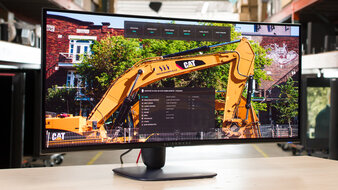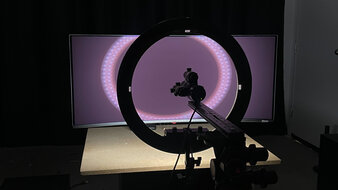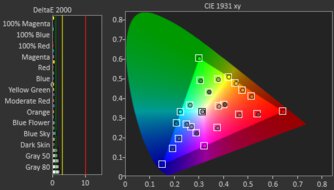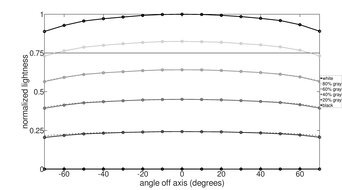Ultrawide monitors are useful for immersive gaming, as you can see more of your surroundings in games than on standard 16:9 monitors. Most ultrawide gaming monitors have a 21:9 aspect ratio with a 34-inch screen, though you can find them in larger sizes, including 38, 40, and 45-inch sizes. Others are larger 49-inch super ultrawide displays with a 32:9 aspect ratio. While the market for ultrawide gaming monitors isn't as diversified as the market for smaller displays, you can still find some great ultrawide gaming monitors. It's important to consider your budget when looking for a monitor, as there are options at a wide range of prices.
There are different factors to consider when looking for an ultrawide gaming monitor. Its response time is important for motion handling, and using VRR also helps reduce screen tearing, with most monitors supporting both FreeSync and G-SYNC. You can also consider the monitor's input lag, but most have low enough input lag anyway. Keep in mind that gaming consoles don't support ultrawide aspect ratios, so these monitors aren't the best choices for consoles.
We've bought and tested over 375 monitors, and below are our recommendations for the best ultrawide gaming monitors to buy. See our recommendations for the best curved gaming monitors, the best ultrawide monitors, the best 34-49 inch monitors, and for other sizes, the best monitor sizes for gaming.
Quick Look





We buy and test more than 30 monitors each year, with units that we buy completely on our own, without any cherry-picked units or samples. We put a lot into each unbiased, straight-to-the-point review, and there's a whole process from purchasing to publishing, involving multiple teams and people. We do more than just use the monitor for a week; we use specialized and custom tools to measure various aspects with objective data-based results. We also consider multiple factors before making any recommendations, including the monitor's cost, its performance against the competition, and whether or not it's easy to find.
-
Best Ultrawide Gaming Monitor
 PC Gaming9.1Response Time9.8HDR Picture9.4SDR Picture10Brightness6.8Size34"Panel TypeQD-OLEDMax Refresh Rate240 HzNative Resolution3440 x 1440See all our test resultsCurve Radius1800R
PC Gaming9.1Response Time9.8HDR Picture9.4SDR Picture10Brightness6.8Size34"Panel TypeQD-OLEDMax Refresh Rate240 HzNative Resolution3440 x 1440See all our test resultsCurve Radius1800RThe best ultrawide gaming monitor we've tested is the Dell Alienware AW3425DW. It's a high-end QD-OLED with fantastic gaming performance and premium picture quality. It has a high 240Hz refresh rate that provides a smooth and responsive feel for gaming, motion looks incredibly sharp, and it supports all common VRR formats to reduce screen tearing. It even supports HDMI 2.1 bandwidth to take full advantage of modern graphics cards and gaming consoles, but you'll see black bars on the sides when gaming on consoles. Besides that, its 34-inch screen with an 1800R curve offers an immersive gaming experience with the edges brought closer to you.
On top of its incredible gaming performance, it displays a wide range of vivid colors in HDR. It also delivers realistic images thanks to its deep and inky blacks next to bright highlights in darker rooms. However, in bright rooms, deep blacks look purple because its QD-OLED panel lacks a polarizer. If you're looking for a monitor that displays deeper blacks even in bright rooms, check out the LG 34GS95QE-B. However, its colors aren't as vivid.
-
Best Super Ultrawide Gaming Monitor
 PC Gaming9.1Response Time9.8HDR Picture9.5SDR Picture10Brightness6.8Size49"Panel TypeQD-OLEDMax Refresh Rate240 HzNative Resolution5120 x 1440See all our test resultsCurve Radius1800R
PC Gaming9.1Response Time9.8HDR Picture9.5SDR Picture10Brightness6.8Size49"Panel TypeQD-OLEDMax Refresh Rate240 HzNative Resolution5120 x 1440See all our test resultsCurve Radius1800RIf you find the 21:9 aspect ratio of the Dell Alienware AW3425DW too narrow and you prefer something wider, then check out a super ultrawide display, like the Samsung Odyssey OLED G9/G95SC S49CG95. With a 49-inch, 5120x1440 display, it's even wider than the Dell, and it's the equivalent of placing two 27-inch monitors side by side. Otherwise, it's very similar because it also uses a QD-OLED panel.
It has the same 240Hz refresh rate with VRR support and HDMI 2.1 bandwidth, and motion looks sharp thanks to its near-instantaneous response time. Like the Dell, it also displays a wide range of vivid colors, and colors are accurate even in SDR, so you won't have to calibrate it unless you need perfectly accurate colors. Additionally, it has the same deep blacks in dark rooms, though, like the Dell, deep blacks look purple in a bright room.
-
Best Upper Mid-Range Gaming Monitor
 PC Gaming8.9Response Time9.9HDR Picture9.3SDR Picture9.9Brightness6.7Size34"Pixel TypeQD-OLEDMax Refresh Rate165 HzNative Resolution3440 x 1440See all our test resultsCurve Radius1800R
PC Gaming8.9Response Time9.9HDR Picture9.3SDR Picture9.9Brightness6.7Size34"Pixel TypeQD-OLEDMax Refresh Rate165 HzNative Resolution3440 x 1440See all our test resultsCurve Radius1800RIf you don't have the budget for a premium ultrawide gaming monitor, you can find the Dell Alienware AW3423DWF for less. It's smaller than the Samsung Odyssey OLED G9/G95SC S49CG95 because it has a narrower 21:9 aspect ratio. It's also a bit different than the Dell Alienware AW3425DW as it has a lower 165Hz refresh rate, so it doesn't feel as smooth or responsive, but motion still looks sharp. It doesn't support HDMI 2.1 bandwidth either, so you can only reach its max refresh rate with a DisplayPort connection.
Like the Samsung and Dell, it has a QD-OLED panel with vivid colors. Additionally, it makes highlights pop in HDR, but it doesn't get bright enough to fight intense glare in well-lit rooms. Besides that, it's another QD-OLED, so there isn't any haloing around bright objects, and it has the same deep blacks in dark rooms. However, like the Dell and Samsung, deep blacks look purple in a bright room.
-
Best Budget Ultrawide Gaming Monitor
 PC Gaming7.6Response Time7.7HDR Picture6.3SDR Picture7.9Brightness7.7Size34"Panel TypeVAMax Refresh Rate180 HzNative Resolution3440 x 1440See all our test resultsCurve Radius1500R
PC Gaming7.6Response Time7.7HDR Picture6.3SDR Picture7.9Brightness7.7Size34"Panel TypeVAMax Refresh Rate180 HzNative Resolution3440 x 1440See all our test resultsCurve Radius1500RShould you want a budget ultrawide gaming monitor, look into the Dell Alienware AW3425DWM. It's an entry-level model that's a step down in performance compared to the higher-end models, as it doesn't have an OLED panel like the Dell Alienware AW3423DWF. This means it has worse picture quality as it doesn't have the same deep blacks with bright highlights and vivid colors, but that's the trade-off for getting something cheaper. That said, it still has a good contrast ratio, and it gets quite bright in SDR.
Another difference with the AW3423DWF is that it doesn't have the same near-instantaneous response time, so motion looks blurrier, and there's smearing with fast-moving objects. However, it has a similar 180Hz refresh rate, and it also supports FreeSync and has G-SYNC Compatibility to reduce screen tearing.
Notable Mentions
-
LG 45GX950A-B:
The LG 45GX950A-B is a unique 45-inch ultrawide OLED gaming monitor with a high 5k2k resolution. This means it delivers more details than the Dell Alienware AW3425DW and has more screen space. However, it costs a lot more than the Dell, so only consider it if you're going to use its bigger screen.
See our review -
MSI MPG 341CQPX QD-OLED:
The MSI MPG 341CQPX QD-OLED is a 34-inch QD-OLED that competes with the Dell Alienware AW3425DW. It performs similarly for the most part, and has a few extra features, like a USB-C port and KVM switch, but it can be harder to find at times.
See our review
Recent Updates
Dec 17, 2025:
We added the MSI MPG 341CQPX QD-OLED to the Notable Mentions.
Sep 02, 2025:
We replaced the LG 34GS95QE-B with the Dell Alienware AW3425DW, as it has more vivid colors and costs less. We also replaced the Dell S3422DWG with the Dell Alienware AW3425DWM, as it has better motion handling and better contrast. Additionally, we removed the LG 34GP83A-B from the Notable Mentions.
May 09, 2025:
We removed the MSI MPG 341CQPX QD-OLED as it's hard to find, and renamed the LG 34GS95QE-B as the 'Best Ultrawide Gaming Monitor.' We also added the Samsung Odyssey OLED G9/G95SC S49CG95 and the Dell Alienware AW3423DWF to their respective categories. Lastly, we moved the LG 34GP83A-B to the Notable Mentions, as it's becoming harder to find, and added the LG 45GX950A-B as a Notable Mention.
Feb 19, 2025:
We removed the Gigabyte M34WQ from the Notable Mentions as it's hard to find. We introduced a new format to the article and updated the text to reflect these changes.
Dec 09, 2024:
Replaced the Dell Alienware AW3423DWF with the MSI MPG 341CQPX QD-OLED, as the MSI has a higher refresh rate. Replaced the Dell Alienware AW3423DW with the Dell Alienware AW3423DWF as a Notable Mention.
All Reviews
Our recommendations are based on what we think are the best ultrawide gaming monitors you can get for gaming. They are adapted to be valid for most people in each price range. The rating is based on our review, factoring in price and feedback from our visitors.
If you would prefer to make your own decision, here is the list of all of our ultrawide monitor reviews. Be careful not to get too caught up in the details. Most monitors are good enough to please most people, and the things we fault monitors on are often not noticeable unless you really look for them.












